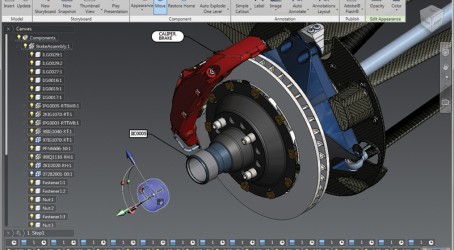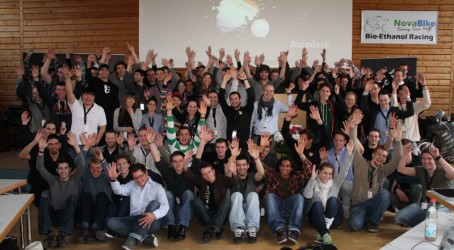It looked like an act of unbridled largesse. Earlier this year Autodesk invited more than 100 of Europe’s brightest engineering students to a picturesque part of Germany for a few days of interactive learning. The students were equipped with laptops and the very latest versions of Autodesk’s software and were encouraged to show off their skills using modelling and simulation tools. The resultant expressions of dextrous competence showed just how comfortable the next generation of technology-savvy mechanical engineers are when it comes to operating in a digital environment.
But no company funds such an event out of sheer goodwill and generosity. Autodesk expected some sort of return on its investment and that it got in spades, with employees from its education department listening to the questions and needs of the students and using the dialogue as a means of guiding future software development. The students got to have a bit of fun with their peers, refining their design skills in a rewarding environment, while Autodesk ensured that innovation would remain at the heart of its new products.
The WoodStEx event highlighted the collaborative relationship that exists between the big software companies and the academic sector. Many of Autodesk’s products such as its Inventor 3D mechanical design software are available to students free or at discounted rates, and its online education community, comprising videos, tutorials and training guides, now has just under three million users worldwide. The company has grasped the fact that if it gets students comfortable with its software while they are at university, they are more likely to use it when they enter the world of work.
“We’ve always recognised that the academic base can be a driver of real product innovation in terms of software,” says Don Carlson, director of Autodesk’s education division for Europe, the Middle East and Africa. “WoodStEx, in particular, was an excellent opportunity to create dialogue between students and industry experts and bridge the two worlds. Whilst listening to their questions and needs, we got to develop a way forward where we could tackle the challenges that come with innovation together.”
Autodesk’s relationship with universities is starting to evolve as the academic landscape is changed by factors such as rising tuition fees and greater mobility of students. In years gone by, there was no real need for universities to differentiate their engineering course content from what other places of learning were offering. That’s not the case now. Students are becoming demanding customers, and universities are working hard to meet those new expectations by forging links with organisations such as Autodesk.
“Universities are increasingly looking at the relevance of their programmes to make sure they meet the needs of today’s market,” says Carlson. “The Bologna declaration means there is now more consistency between universities across the European Union and further afield. That allows students to become more choosy about the university they select.
“And then there are other factors such as tuition fees – students are increasingly saying ‘if I am paying this amount, I want to make sure I am getting value for my money’. So there is a willingness from academia to talk to companies such as Autodesk and other professional organisations – not just about things like discounted software, but about taking a more holistic view and forming real partnership arrangements.”
The most recent educational content delivered by Autodesk to students through its online educational resource addresses building strategies, materials selection and energy effectiveness. The Sustainability Workshop provides free content demonstrating how sustainability principles can be used to solve real-world environmental challenges. The resource includes videos, tutorials and case studies, enabling design, engineering and architecture students to learn how to put sustainable design concepts into practice.


The aim of the content is to break down difficult, abstract concepts, such as materials science, heat transfer and fluid mechanics, into visual, bite-sized pieces of information. This should help students to devise strategies and techniques around selecting the right materials and using energy more effectively. It should help to make them better designers.
Students learn how to use convection, conduction and radiation to design passive heating, ventilation and air-conditioning systems, reduce energy use, and ultimately build net-zero energy buildings. Materials Selection reveals the ecological impacts of specific materials and different material choices, helping students make selections that have the least environmental impact. The strategies presented illustrate the trade-offs to consider, together with methods for improving the materials selection process, to make more sustainable design decisions.
Energy-effective design content, meanwhile, demonstrates how design and engineering decisions can reduce energy waste and cut consumption. The learning tools cover mechanical friction, fluid flow and heat transfer, and show ways to optimise a design for energy effectiveness and efficiency.
“The online educational resource has about 30 Autodesk products that students can download and use as part of their studies,” says Carlson. “Some lecturers don’t have time to teach their students how to use the software, so students have to do a lot more on their own through self-help resources and obviously we are trying to support that. These days students are comfortable learning online – they don’t need 300-page booklets.”
With one eye on the future, Carlson says Autodesk is always looking at ways to extend its links to the education sector. Again, that word holistic crops up, with the company keen to expand the use of its software from areas such as gaming and animation into traditional subjects such as English and history.
“We want to engage and inspire students in subjects that might be considered as being positioned horizontally, rather than vertically, to what we already do,” he says. “Students look at things very differently now than they did 10 years ago – so there is more scope to use technology in these sectors of learning. Our education support is engrained in the culture of the organisation and we think we have a very good opportunity to continue that work.”

Winning formula for schools
All major engineering software vendors provide their software free or at heavily discounted rates to university students. But, increasingly, CAD software is being used in classrooms before university level.
SolidWorks, for instance, sponsors the F1 in Schools project, which capitalises on the allure of Formula One racing to tempt students into engineering. Students use SolidWorks to design a racing car, then analyse its drag coefficiency using computational fluid dynamics software.
They then use the software again to evaluate the best way to make the car, build a model out of balsa wood, test the vehicle in wind and smoke tunnels and race it in a competition. Students also assess the environmental impact of their design using SolidWorks.
The SolidWorks student design kit is functionally identical to software used by professionals. It includes PhotoWorks and Animator, eDrawings and CosmosXpress finite element analysis software. It has extra characteristics that differentiate it from the commercial version including on-screen and printing features that identify that the software and the files created are for academic use only.